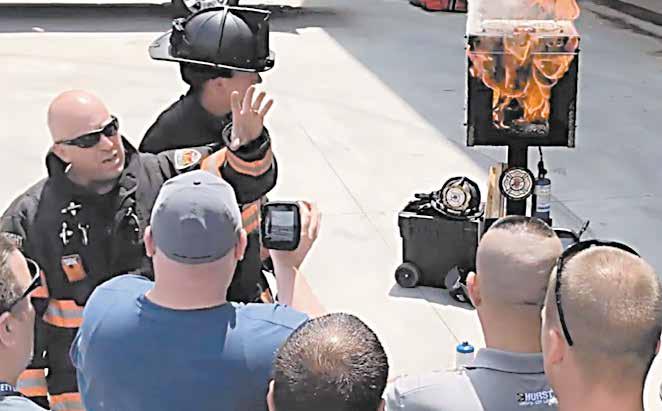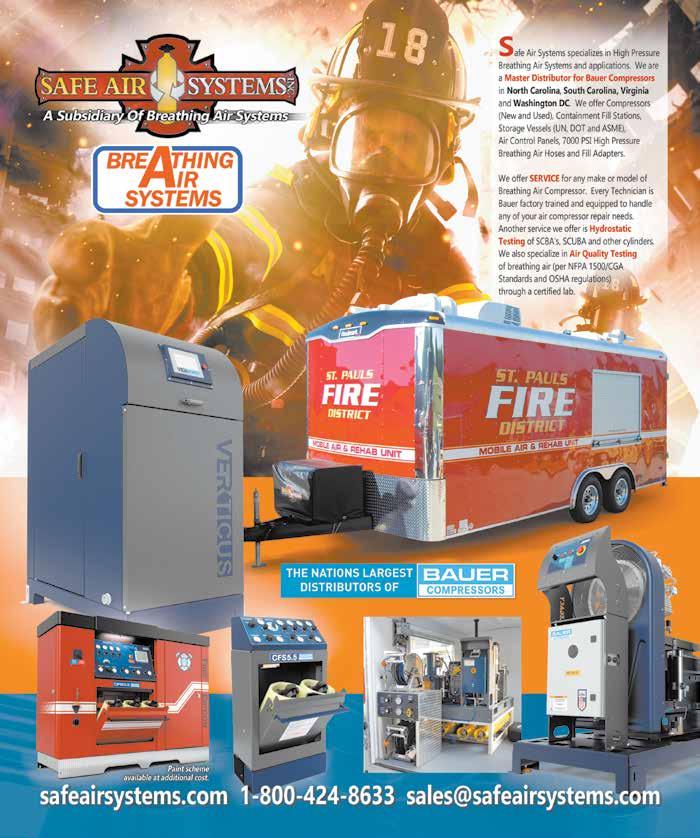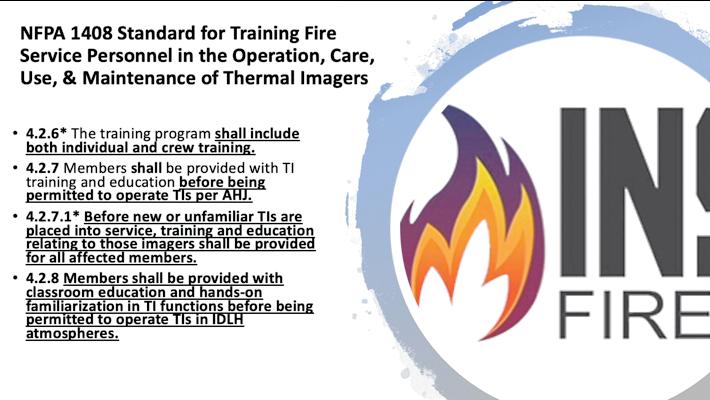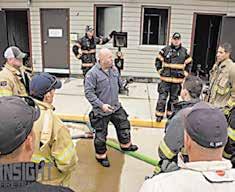
10 minute read
Thermal Imaging
The Case for Thermal Imaging Training
In researching and training in the area of thermal imaging we continue to see firefighters failing to either deploy or Andy Starnes use their thermal imaging camera (TIC) on the fireground, and/or they are not trained on how to properly use it.
Advertisement
According to NIOSH, in 38 percent of Line of Duty Deaths studied, the thermal imaging camera remained on the charger in the fire truck. And in a recent study in 2020, regarding thermal imaging usage conducted in partnership with Firehouse Magazine, firefighters stated they left the thermal imaging camera on the truck as much as 50 percent of the time on Non-EMS related calls.
Many fire departments across the United States lack the financial capabilities to keep up with every consensus standard change. And in some cases, these standards are not considering those departments when they are approved. In a court of law however, Curt Varone shares some important expertise on this subject:
“In fact, lawsuits arising out of firefighter LODDs and injuries reference National Fire Protection Association (NFPA) standards on a regular basis. Most competent attorneys today seek to use industry standards as evidence of the applicable standard of care regardless of the type of industry. When it comes to the fire service, NFPA standards are the definitive standards that knowledgeable attorneys will default to. NFPA standards are evidence of what the reasonably prudent fire department would have done under the circumstances.” (Curt Varone)
In 2015, NFPA introduced NFPA 1408 Standard for Training Fire Service Personnel in the Operation, Care, Use, and Maintenance of Thermal Imagers. This standard outlines the requirements for departments regarding training, policies, use and more. However, many fire departments fail to acknowledge it or are even aware of its existence.
Thermal imaging is not a new subject or area for the fire service. However, since its introduction to the fire service it has lacked a very important fundamental asset that has Photo Courtesy Curt Varone been continually overlooked. This is the area of training and education. Originally, when fire service thermal imaging cameras were introduced to the fire service a portion of the purchase price went to pay for the education and training on the device. Unfortunately, as time went by, this practice did not continue. And much to the fire services dismay, often the smallest budgetary line item is the one that is the most important to providing service to the citizen. This item is known as the training budget. This has led to a massive educational gap in proper interpretation and usage of this life saving device. This is evident by teaching internationally, the majority of the students have never had a formal thermal imaging training and education program. This was also recently confirmed by a nation-wide survey that we assisted in developing through Firehouse Magazine. The results may have been shocking to some but they were not surprising to those who are working to educate firefighters in the area of thermal imaging.
Here are a few of the results from the survey:



TIC Decision Making and Situational Awareness
Nearly 42 percent of respondents did not know the difference between the two types of thermal imaging cameras in use today. If a member who is familiar with the functionality that a decision-making model provides concludes that he/she has access to the same performance via a situationalawareness TIC, he/she can be put in danger.
Regarding NFPA 1408- Standard for Training Fire Service Personnel in the Operation, Care, Use and Maintenance of Thermal Imagers: • 32 percent of respondents said that their department’s training is based on NFPA 1408. • 25 percent stated their department’s training was not based on NFPA 1408. • 23 percent weren’t aware that an
NFPA standard regarding thermal imager training exists.
Regarding Thermal Imaging Training: • 75 percent of the respondents stated their departments provided thermal imaging training. • Nearly 50 percent of those provided one to two hours of training. • One-fifth of the respondents were provided three to eight hours of training. • One-fourth of all respondents received NO thermal imaging training from their department withing the past year.
This information and more points to a great educational and training gap in the area of thermal imaging use in the fire service. However, this is not to say that there aren’t departments who are ahead of the curve regarding thermal imaging training. Unfortunately, the United States Fire Administration points out another troubling statistic: • “In 2015 70 percent of fire departments surveyed stated they had a thermal imaging camera on every fire scene. “ (Fourth needs assessment of the U.S. Fire Service,
USFA)
All of this data points toward an incoming train wreck of accountability and ignorance. Litigation is becoming the norm in fire departments across the world on various topics. In the following chart we see the most common area in which fire departments are sued is structure fires.
The challenge for the modern fire service is to be proactive and stay ahead of foreseeable tragedies. The purpose of a fire department is to save lives and property through prevention, training, inspections, code enforcement and responses to fire emergencies. In many cases, the fire department is caught in a very difficult place especially in today’s world. They are fighting budget cuts, staffing reductions/lay-offs, and the current challenges of COVID-19 have made staffing apparatus even more difficult. However, when discussing training and education, the sad statistical fact is that the smallest budget among most fire departments is the one of the most utmost importance: training.
“As public safety is a labor-intensive service model; typically, more than 90 percent of the budget is accounted for by personnel costs. An additional five to seven percent is usually assigned to fixed costs for items such as apparatus parts and repairs, fuel, hose, equipment, station supplies and station maintenance. Ultimately, there is typically less than five percent discretionary spending capacity that frequently covers unexpected expenses.” (Steven Knight, Ph.D.)
Let us pose some very possible yet hypothetical situations for the reader to consider. What will be the outcome when a major incident leading to line of duty death of a firefighter occurs and the investigation reveals that the firefighters who died and those around them attempting to rescue them were never properly trained on the operation of the thermal imaging cameras issued to them?
What will happen in a court of law when a fire department rescues a child from a burning structure but did not use their thermal imaging camera during the search? What will happen when the child passes away from his/ her injuries? What will happen when a grief stricken parent stands before a jury holding the thermal imaging camera that their tax dollars paid for and he or she quotes the following information:
“FDNY, Boston, and Chicago all located the victim up to 70 percent faster when using a thermal imaging camera during a search but without one they missed the victim 60 percent of the time.” (M. Whitty p.5).
What will be the final outcome when a fire chief of a large well-funded department is asked the following? • Does your department have a TIC training program? • Do they have written polices for
TIC training? • Do they address the training requirements for types of incidents? • Do they perform annual review of
TIC training with classroom and live fire? • Did your department train you on the TIC before placing it in service?
And the answer is NO!
Will the court, the firefighter’s families, the victims’ families, and the property owners understand that their fire department claims an exemption from this standard? Will they be understanding that the fire department wasn’t aware of this training requirement? How will fire departments explain to all parties mentioned above that they had the
see THERMAL IMAGINING page 12

Cont’d from page 11 funding to buy equipment but lacked the funding to properly train their firefighters on the proper operation of this device? Fire departments across the globe are being asked to provide more services with less staffing and less funding each year. If their service levels are to increase and improve, all while absorbing new areas of service, there should logically be an increase in funding and support for the fire service.
Thankfully, there are many opportunities that can assist with training from local support within the community such as grants from such organizations as The Firehouse Subs Public Safety Foundation. Fire departments should be seeking grant assistance for AFG grants and to fill the gaps in their funding or budgetary process.
With the challenges of COVID-19, fire departments have had to adapt to

Photo courtesy Firehouse Subs Public Safety Foundation virtual platforms, training events have been canceled or greatly restricted, and operational in-service training has been challenging due to firefighters being at risk for additional exposure. There are many virtual platforms that can provide firefighters with a solid foundation and understanding of thermal imaging cameras before they begin their hands on training component. There are many cost effective ways of providing classroom, hands-on, and live fire demonstrations such as the Max Fire Box or Doll House Fire Burns to teach firefighters to properly use their thermal imaging camera. However, the practice of purchasing equipment and placing it in service without properly training those tasked to use it must stop. Firefighters should be adequately trained in the basic operation, contraindications, and fire ground applications of a thermal imaging camera so they can enhance their fire ground strategies and tactics. Lifesaving equipment should be purchased with the cost of training included or as a part of the overall plan. Critical infrastructure such as the fire department, cannot expect top-notch performance when they fail to provide the education and training necessary to maximize a tool’s effectiveness in the hands of their firefighters.
Therefore, it is up to the fire service to do as it has in its past: adapt, improvise and overcome. It is time for the fire service to require that manufacturers provide more in-depth training as part of the purchase to lessen the burden upon the already crippled budgets of the fire department. It is time for organizations such as the IAFF, IAFC and the NFFF to lobby for more grant funding for training than ever before. It is time for the taxpayers to learn just how many services their fire departments provide with little or no training provided to the firefighters. It is time for firefighters who are subject matter experts within their own fire department to be utilized as valued assets to enhance the organizations overall level of performance. It is time for the fire service to look within for the answers and use its greatest strength: each other!
Our ability to serve the citizens can be provided, improved, and gaps in training can be filled through our collective efforts. However, it will take bold leadership that is courageous enough to ask its own firefighters for help, listen to their counsel and implement those solutions in a timely fashion. It will take innovative solutions from manufacturers who produce not just a product but a life saving device that demands training and education. In closing, those who seek to improve upon the service delivery model of the future will be known as the “intelligently aggressive” firefighters of tomorrow.




Works Cited:
https://www.firechief.com/fire-chief/ articles/doing-more-with-less-firedepartment-budgets-fiscal-responsibilityGTj33j3axJ2tfshe/ https://firehousesubsfoundation.org











